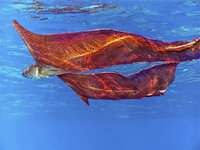Imagine if your spouse was 40,000 times heavier and a hundred times larger than you. This is reality for the male blanket octopus, which was recently spotted alive for the first time off Australia's northern coast.
Australian and British marine biologists stumbled across the diminutive male octopus while scuba diving in the Great Barrier Reef. Divers spotted a male 2.4 centimeters (0.9 inches) long. By contrast, females of the species grow up to two meters (6.6 feet) long.
"Imagine a female the size of a person and the male a size of a walnut," said Tom Tregenza, an evolutionary biologist at the University of Leeds in England. Tregenza co-authored the study that reported the find in the latest issue of the New Zealand Journal of Marine and Freshwater Research.
Dead blanket octopus males (Tremoctopus violaceus) have been collected before in plankton nets. But the recent observation marks the first time one has been spotted swimming about in its natural environment.
Evolutionary Oddity
"This is certainly the most dramatic example of sexual dimorphism in any large animal," said Tregenza. So-called sexually dimorphic species are those, like humans, whose males and females are of different average sizes.
Blanket octopuses are rarely seen. They spend their entire life drifting in the open oceans of warm regions worldwide. Females have the odd appearance of a "big pink drifting blanket" said Tregenza, explaining the origins of the octopus's name.
Among their more unusual behavior, the octopuses employ a unique defense mechanism by tearing off the tentacles of passing Portuguese man-of-war jellyfish. The octopuses are immune to the tentacle's painful sting. When they encounter potential predators, the octopuses waft the captured man-of-war tentacles in two pairs of its upper arms as an effective deterrent.
The male blanket octopus recently photographed by researchers was shown to clutch tentacle segments in his suckers, said Tregenza.
Blackwater Hang
Study co-authors Mark D. Norman of the Museum Victoria in Melbourne, Australia, and David Paul at the University of Melbourne photographed the animal while on a type of late-night diving expedition known as a blackwater hang.
Such expeditions involve taking a boat to sea on moonless nights and suspending a diver up to 20 meters (66 feet) into the pitch-black water. The researchers then waited in the eerie silence and used torches as light sources in the hope of attracting interesting passers-by, said Tregenza.
The male octopus, which approached them from the depths, weighed in at no more than a quarter of a gram (0.08 ounce) and was only 2.4 centimeters (0.9 inch) long. Norman, an octopus identification expert, knew he'd found something unusual because he didn't immediately recognize the species, said Tregenza.
Later comparison with museum specimens revealed the unusual nature of the find.
A female specimen also examined in the Museum Victoria was 80 centimeters (2.6 feet) long and weighed in at nearly three kilograms (8 pounds), or more than 10,000 times heavier than the tiny male.
The largest females of the species are almost twice as long and are likely to weigh as much as 10 kilograms (27 pounds), almost 40,000 times as heavy.
Lucky Break
Some of the most extreme examples of size differences between the sexes come from marine and parasitic animals, where males find it difficult to locate females.
The male octopuses' chances of finding a mate "are in the hands of fate," said Tregenza. Greater size, therefore, doesn't offer males any significant advantage in tracking down a female mate. Instead of wasting time growing to maturity, the best strategy is to start searching for mates as early as possible, Tregenza said.
Contrary to males, however, female blanket octopuses may benefit from being large. "The amount and size of offspring produced is determined by the size and condition of the female," commented James B. Wood, an octopus biologist at the University of Texas Medical Branch in Galveston.
"Many generations of small males can be produced in the amount of time it would take to produce a larger male," said Wood. In essence, the males appear to be using a "live fast and die young" strategy, he said.
If a male does chance across a female, it uses all its resources in an attempt to mate, "as he's unlikely to encounter another one," said Tregenza. A male blanket octopus fills a modified tentacle with sperm, tears it off, presents it to its prospective mates, and then drifts off to certain death.
Females store the tentacles inside large internal body cavities until they are ready to lay their eggs. At that time, the female pulls the tentacle out and "squeez[es it] like a tube of toothpaste," over the eggs, said Tregenza.
The sole reason scientists know that the mismatched sexes are the same species, is because females have often been found with male tentacles inside them.
Finding a live male is an intriguing discovery, commented Wood, who added that the scientific community knows very little about the open-ocean, deep-sea animals.
"The continued search for an alive adult giant squid in its natural habitat illustrates this point well," said Wood. "If we haven't been able to observe a 60-foot [18-meter] squid in its natural habitat, think of how many smaller species are waiting to be discovered."

